| |
Comfort in the passive house - why better thermal insulation always leads to better comfort |
|
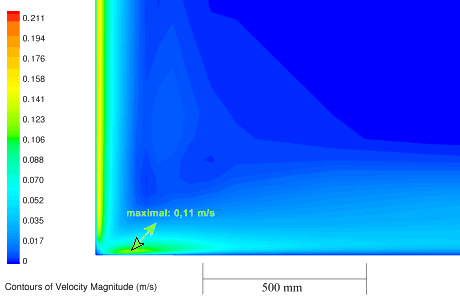
Fig. 1: Air movement
near to a Passive House window: Due to the small temperature
difference between window surface and room air, the speed of air sinking
at the window is small. At the floor, approximately 10 cm horizontally
from the passive house window (U=0.8 W/(m²K)) the maximum air speed
is a barely noticeable 0.11 m/s. If the insulating value of the window
is worse, then air speed rises to disturbingly high values. Therefore
it is recommended, with "normal windows", to position a heating element
under the window.(CFD simulation: J. Schnieders, PHI)
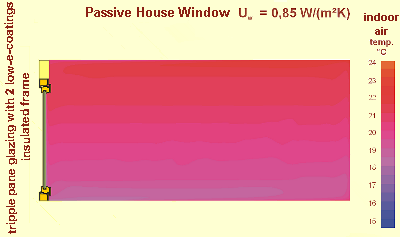
Fig.
2 Stratification: The temperature stratification of air is
also imperceptible with the passive house window. Therefore the heating
element can be placed also at an inner wall while still reaching optimal
comfort in accordance with ASHRAE Comfortclass "A". (computation: J.
Schnieders, PHI). A comparison with a "normal window" in a short film
you can watch
here.
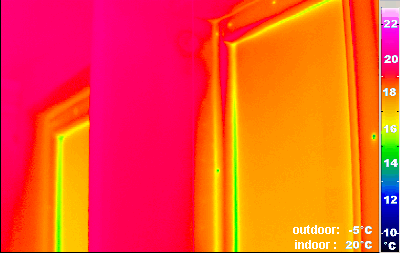
Fig. 3 Passive
House Practice: Infrared image of the interior side of a passive
house window. All surfaces (wall structure, window frame, and the glazing)
are pleasantly warm (over 17 °C). Even at the glass edge, the temperature
doesn't fall below 15 °C (light-green portion)
(Source: PHI, from the
Passive House Kranichstein).
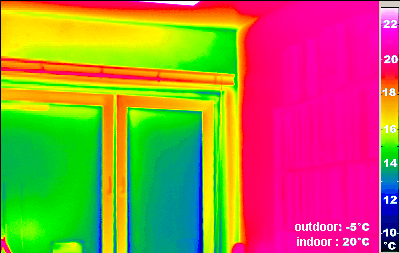
Fig. 4 Typical
Practice: For comparison, here is a typical old building's
window. The center of glass surface temperature is already below 14 °C.
In addition, there are large installation thermal bridges, particularly
where the window meets the concrete wall. The consequences: significant
eadiant temperature asymmetry, drafts, and pooling of cold air in the
room.
(IR-fotography: PHI, image taken at the office of PHI)
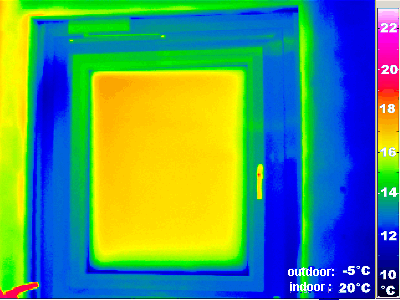
Fig. 5 low-e glazing (2 panes) already have higher surface temperatures (16 °C in the average). Additionally, the poor insulation of the conventional window frame is remarkable. Passive house frames allow a dramatic improvement in insulating quality. (IR fotography: PHI, in the corridor of the institute)
Go to the Main Page of the Passive House informational pages: Passive house fundamentals.
Go to the homepage of the passive
house conference:
Passive
house conference.
Go to the Passive House Institut
homepage: ![]()
Comfort is determined by many very subjective feelings, even the color of the environment plays a certain role - with each person being influenced uniquely. However, it is well documented that a substantial part of comfort depends on "thermal comfort". The results are contained in International standards (ISO 7730) with a major portion due to the work of the Danish scientist P. O. Fanger
Fanger's comfort equation is derived from the concept that for optimal thermal comfort the heat loss of the human body is in an equilibrium with its heat production. This forms a relationship between the activity (e.g. sleeping, running...) and clothes as well as the properties of the thermal environment, which are:
- air temperature
- the temperature of the surrounding surfaces,
which one can summarize as the "radiant temperature", - air speed and turbulence
- humidity of the air.
There is a range of combinations of the four comfort parameters mentioned in which the comfort is very good: This is the so-called comfort field. It can be determined by the Fanger equation, documented in ISO 7730. It continues to be important according to this standard that
- the air is not too humid,
- air speeds remain within the acceptable limits (for speeds under 0.08 m/s, less than 6% of people will feel a draft)
- the difference between radiant and air temperature remains small,
- the difference of the radiant temperature in different directions remains small (less than 5 °C; "radiation temperature asymmetry")
- the room air temperature stratification is less than 2 °C between head and feet of a sitting person
- the percieved temperature varies less than 0.8 °C within the living area.
Regarding the last point, P.O. Fanger writes: "the greater the variation of the thermal field of an area, the greater the expected number of dissatisfied people."
What does this have to do with the Passive House?
It is exciting that by the requirements of the passive house standard all comfort criteria are automatically optimally fulfilled - substantially improving the thermal insulation simultaneously improves thermal comfort. This can be understood as follows:
- By improving thermal insulation (regardless of which external building building component, e.g. wall, roof, floor, etc.) the heat flow from the inside to the outside is reduced.
- Therefore the heat flow of the room area to the interior surface of this external building component is also reduced. That heat flow has to flow through the thermal film coefficinet of the surface (radiation and convection).
- The smaller heat flow implies a resultant smaller drop of temperature over this thermal resistance. In other words:
- There is a smaller temperature difference between the room area (the surfaces in the area and the room air) and the interior surface of the well insulated building component.
The practical consequence: With highly insulating external construction components, the temperature of the interior surface is only slightly different from the other temperatures in the area; this applies both in summer and winter. In the winter, the interior surfaces of the external construction components are comfortably warm (external walls, roofs etc. at the most 1 °C under the ambient temperature, window surfaces maximally 3 to 3.5 °C under it [ 1 ]). The definition of "Passive House quality" windows is straightforward: The insulating efficiency of a window suitable for Passive Houses must be so good that under the coldest design conditions, the equation:
θ area - θ Oberfl ≤ 3.5 °C
still holds true. These small temperature differences have the following affects on the comfort criteria:
- Air speeds in the area
(apart from leaks) are due to free convection at cooler surfaces.
Due to the small temperature differences the convective currents,
and consequently air speeds, are now very small.
Fig. 1 in the left column shows a CFD (Computational Fluid Dynamic) simulation result: There is no draft in the room, even without a heating element under the window. - If the external surface temperature is not more than 3.5 °C below the ambient temperature, then the radiant temperature difference in different directions cannot be greater than 3.5 °C. The thermography photographs in Fig. 3 to Fig. 5 show the difference between windows of various insulating quality.
- The room air temperature stratification between the head and feet of a sitting person is less than 2 °C - however only under the condition that the effective median U-value of the external building components is under 0.85 W/(m²K). See Fig. 2 in the left column.
- The percieved temperature varies less than 0.8 °C within the area.
Because all of the comfort criteria are fulfilled, without the need for a compensatory radiation heating surface, everythere in the Passive House there is "automatically" a radiant heat climate, independently of how the heat is supplied. More still: since there are no large temperature differences, air movement remains small. The results represented here are documented in the publication [ 1 ] (internet source, German).
The comfort characteristics of well insulated buildings can be observed in practice and is confirmed by three independent research results:
- Thermography photographs
and air temperature and speed measurements in passive houses confirm
experimentally the results presented here.
[ 2 ] (see also this page) - Physiological measurements of Bernhard Lipp documenting the comfort feeling. [ 3 ]
- Sociological questionings of a sample group of inhabitants revealed good remarks about well insulated buildings. [ 4 ]
Also at the current Passive House conference there will be a discussion of the comfort topic.
Literature:
[ 1 ] Pfluger, R.; Schnieders, J.; Buyer, B.; , W. Feist: Highly insulating window systems: Investigation and optimization in the installation (appendix to interim report A), Internet publication (German)
[ 2 ] Schnieders, J.; Betschart,
W.; , W. protects: Room air currents in
the passive house: Measurement and simulation HLH 03-2002, page 61
Edited version online: Inhabitant
experience (German)
[ 3 ] Lipp, B.
and Moser, M.: Heating systems and comfort: Is comfort physiologically
measurable? in: AkkP proceedings NR. 25, Darmstadt, 2004
Edited version online: Comfort
(German)
[ 4 ] Hermelink,
Andreas: Do desires become true? Temperatures in passive houses
for tenants; in: AkkP proceedings NR. 25, Darmstadt, 2004
Edited version online: Tenant
questioning (German)
To in this connection the question of the importance of the heat capacity is often discussed. Further information on this topic: Daemmen_oder Speichern.HTML.(German)
(revised:
2007-04-28 Author:
Dr. Wolfgang Feist © Passive House Institute;
unchanged
copy permitted - please give reference to the source
thanks to David Stecher for proof reading)